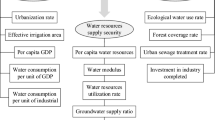Abstract
In order to estimate water resources renewability scientifically, an Ideal Interval Method of Multiple Objective Decision-Making (IIMMODM) is presented. This method is developed through improving an ideal point method of multiple objective decision-making. The ideal interval is obtained with assessment standard instead of ideal points. The weights are decided by using the basic point and gray code accelerating genetic algorithm. This method has synthesized the expert’s suggestion and avoided giving a mark for the objective again. It could solve the complicated problem of compatible or incompatible multi-objective assessment. The principle of IIMMODM is presented in this paper. It is used to assess the water resources renewability for nine administrative divisions in the Yellow River basin. The result shows that the water resources renewability in the Yellow River basin is very low. Compared with the gray associate analysis method, fuzzy synthesis method and genetic projection pursuit method, the IIMMODM is easier to use. Compared with the ideal point method of multiple objective decision-making, the IIMMODM has good robustness, which is applicable to the comprehensive assessments of water resources.
Similar content being viewed by others

References
Xia, J., Wang, Z. G., Liu, C. M., The renewability of water resources and its quantification in the Yellow Riverbasin in china, Acta Geographica Sinica (in Chinese), 2003, 58(4): 534–541.
Zeng, W. H., Yang, Z. F., Principium of the renewability of water resources, Advances in Water Science (in Chinese) 2001, 12(2): 276–279.
Shen, Z. Y., Yang, Z. F., Liu, C. M., Water Resource Renewability and its Relationship with Refresh Rate, Journal of Geographical Sciences (in Chinese), 2002, 22(2): 162–165.
Hwang, C. L., Lin, M. J., Group Decision-Making under Multiple Criteria: Methods and Applications, Berlin Heidelberg, New York: Springer-Verlag, 1987: 23–41.
Saaty, T. L., A scaling method for priorities in hierarchical structures, Journal of Mathematical Psychology, 1997, 17(15): 234–281.
Chu, A. T. W., Kalaba, R. E., Spingam, K. A., Comparison of two methods for determining the weights of being to fuzzy sets, Journal of Optimization Theory and Application, 1979, 27: 531–538.
Wang, L. F., The Introduction of Analytical Hieraichy Process (in Chinese), Beijing: Renmin University of China Press, 1990, 5–18.
Ma, Y. D., Hu, M. D., Improved analysis of hierarchy process and its application to multiobjective decision, Xitong Gongcheng Lilun Yu Shijian (in Chinese), 1997, 17(6): 40–57.
Deng, J. L., Theory of Gray System (in Chinese), Wuhan: Huazhong University of Science and Technology Press, 2000.
Shen, Z. Y., Yang, Z. F., Index system and method for assessing water resource renewability, Journal of Natural Resources (in Chinese), 2002, 17(2): 188–197.
Han, Z. Z., Zhou, S. R., Wu, Q. D., et al, Study on fuzzy statistic and comprehensive assessment for active region, Science in China, Ser. A (in Chinese), 2001, 31(3): 272–277.
Jiang, X. P., Ma, N. H., Research on PCA and its application in multi-criteria evaluation, Xitong Gongcheng Lihin Yu Shijian (in Chinese), 1997, 17(4): 110–115.
Xue, J. J., Yao, G. J., Application of artificial neural network in assessing water quality, Shui Wen (in Chinese) 1997, 17(3): 37–39.
Li, Z. Y., Projection pursuit technique and its application and advance, Journal for Nature (in Chinese), 1997, 19(4): 224–227.
Zhang, X. L., Ding, J., Li, Z. Y., et al., Application of new projection pursuit algorithm in assessing water quality, Acta Scientiae Circumstantiae (in Chinese), 2000, 20(2): 187–189.
Jin, J. L., Wei, Y. M., Ding, J., Projection pursuit model for comprehensive evaluation of water quality, Acta Scientiae Circumstantiae (in Chinese), 2001, 21(4): 431–434.
Zhou, W. K., Wu, Z. Y., Ju, T. Y., A synthesized method for group’s multiple objective decision-making, Journal of Southweat Jiaotong University (in Chinese), 2001, 36(1): 100–103.
Qian, S. D., Gan, Y. G., Tian, F. et al., Operational Research (in Chinese), Beijing: Tsinghua University Press, 2002, 451–452.
Chen, W., Li, F. X., Mei, P., A multi-objective decision-ideal point method for comprehensive assessment of water quality, Environmental Engineering (in Chinese), 2002, 20(3): 64–65.
Yang, X. H., Yang, Z. F., Li, J. Q., Genetic projection pursuit method for comprehensive assessment of regional water resource potentiality, Advance in Nature Science (in Chinese), 2003, 13(5): 554.
Author information
Authors and Affiliations
Rights and permissions
About this article
Cite this article
Yang, X., Yang, Z., Shen, Z. et al. thtAn ideal interval method of multi-objective decision-making for comprehensive assessment of water resources renewability. Sci. China Ser. E-Technol. Sci. 47 (Suppl 1), 42–50 (2004). https://doi.org/10.1360/04ez0004
Received:
Issue Date:
DOI: https://doi.org/10.1360/04ez0004



